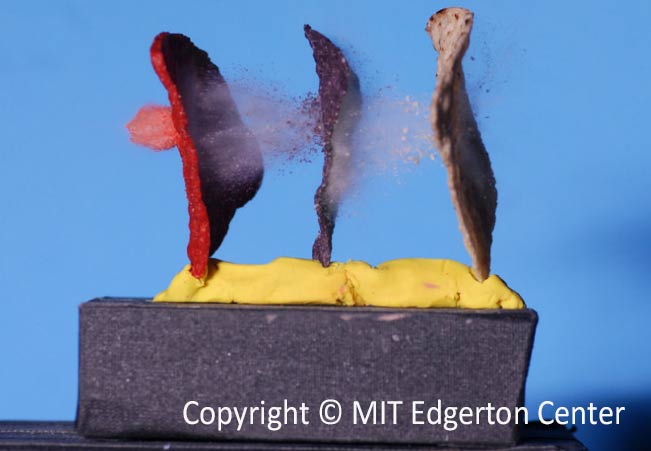Registration has started at Edgerton Center from the Massachusetts Institute of Technology (MIT) for the yearly high speed imaging course geared at the principles of shooting and preparing slow motion setups. The course goes deep into the science and art of slow motion video and has access to some of the most capable high speed gear so that students can use and experiment with first hand experience.
Previous courses have been a great success and the imagery coming out of these classes is pretty jaw dropping. If you can attend the course in June this year it could be just what you were waiting for to jump into the slow motion realm. Access to this gear is few and far between for even experienced personnel and videographers; plus learning from experts in the field can come in very handy to get better knowledge about the process.
Hi Speed Imaging Course Details Below:
This course has limited enrollment. Apply early to guarantee your spot.
To view pictures from prior courses, please visit: https://www.flickr.com/photos/mitedgerton/sets/72157656537454162/with/23999347674/
HIGH-SPEED IMAGING FOR MOTION ANALYSIS: SYSTEMS AND TECHNIQUES
OVERVIEW
This program is designed for scientists, engineers, and imaging specialists who need to gather data on rapidly moving subjects and events for study, motion analysis, and trouble-shooting. Mornings are spent in the lecture hall learning the fundamentals of lighting, imaging technologies, and motion analysis. Afternoons are spent making high-speed images in the laboratory. In addition to carrying out the standard techniques, attendees will try out the latest in high-speed-imaging equipment, with the manufacturer’s representatives there to provide hands-on education and experience with the systems. The course is held at the Edgerton Center at MIT — the home of Doc Edgerton’s Stroboscopic Light Laboratory, where much of the history of the field was written.
With support from the leading manufacturers and consultants, this program features the broadest experience available anywhere in high-speed electronic imaging and image analysis. The scope of the program should make it invaluable to anyone who wishes to broaden their capabilities in the field of high-speed imaging.
Double Drop Collision by MITEdgertonCenter:
UNIQUE FEATURES OF THIS PROGRAM
Hands-on experience: This course emphasizes hands-on experience! Approximately 50% of our time is devoted to intensively immersing each attendee in practical laboratory work. Lectures by experts in their fields and study materials help attendees prepare for laboratory work by providing the requisite theoretical and practical insights.
Use the techniques you study: All attendees participate in lab experiments selected from an unparalleled variety of topics. Experiments include high-speed cameras, lenses and lighting, the latest imaging technologies, as well as specialized techniques such as Schlieren imaging, streak cameras, and pulsed laser illumination.
Learn the details through experiments: Experiments are performed in small working groups, with experts in that technique on hand to answer questions and enter into extensive discussions. The lab experiences are structured to encourage participants to use their imaginations and to experiment with the technique under study. Attendees may bring with them work-related problems that will make suitable experimental subjects to be shared with the class, but please consult with the course staff in advance.
MIT Edgerton Center: The MIT Edgerton Center was created in 1992 to carry on the legacy of the late Professor Edgerton. Its three-fold mission is to be a center of excellence in high-speed imaging within MIT, to provide students at MIT with opportunities for hands-on learning, and to continue Edgerton’s legacy of communicating the importance and excitement of science and technology to the larger community.
To view pictures from prior courses, please visit: https://www.flickr.com/photos/mitedgerton/sets/72157656537454162/with/23999347674/
Takeaways from this course include:
- Defining the fundamental principles of high-speed photography and videography, both for human interpretation and for motion analysis with a computer.
- Making the trade-off between depth-of-field, field-of-view, resolution, and lighting requirements by selecting the appropriate lens(es) to capture clear, crisp, images of the event under study.
- Selecting the correct lighting technologies and design the lighting arrangements for an experiment.
- Analyzing the resulting images to get a real world understanding of how a specific technology may apply to an application.
- Assessing methods of merging high-speed electronic images and instrumentation data for in-depth analysis of mechanical events.
Who should attend:
This course is aimed at all professionals, and is applicable to any individual in an industry, academic, or government sector who must:
- Test, maintain, or troubleshoot high-speed manufacturing equipment
- Evaluate how products withstand impacts
- Observe projectiles in flight or upon impact
- Visualize flows in aerosols, liquids, or granular materials
- Capture the motions of people, animals, and objects
- Study crash tests
- Understand any actions that occur too fast for the eye to follow
Relevant industry sectors include manufacturing, academic research, energy, biotech, aerospace, and ballistics.
- Lead Instructor(s): James W. Bales
- Dates: Jun 26, 2017 – Jun 29, 2017
- Course Length: 4 Days
- Course Fee: $2,900
- CEUs: 2.6

